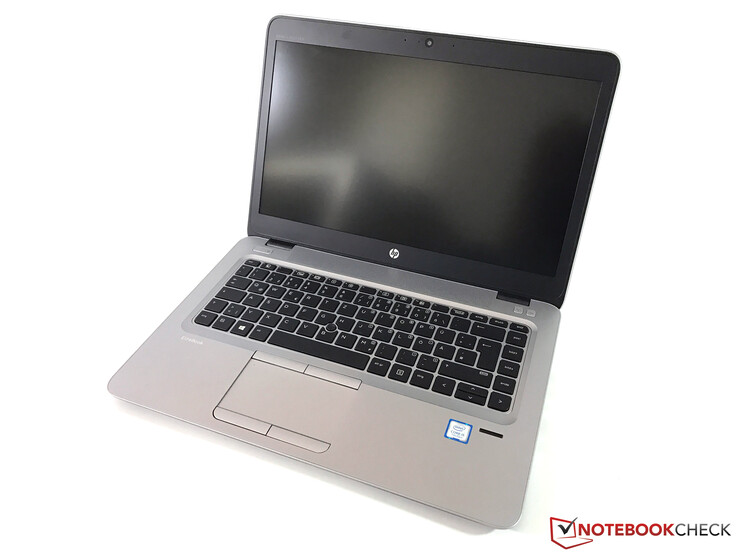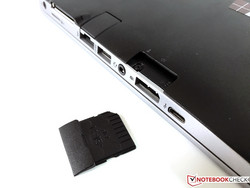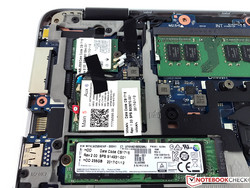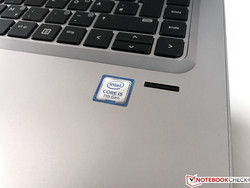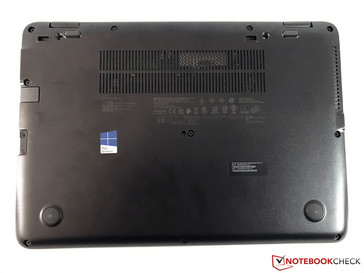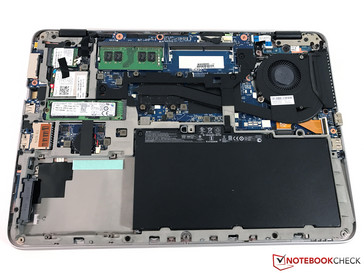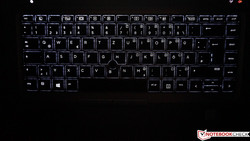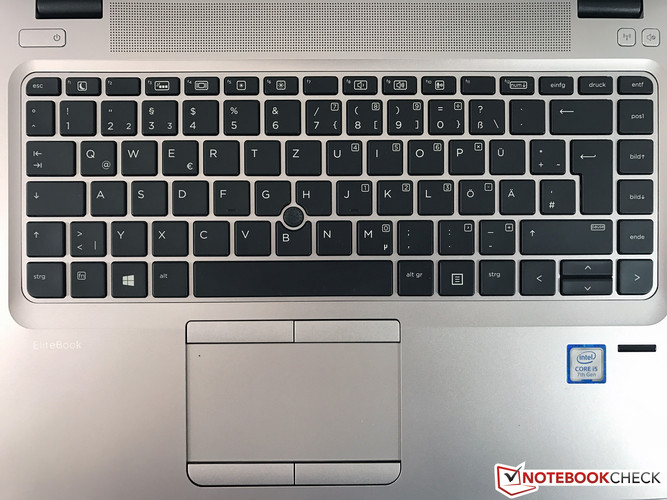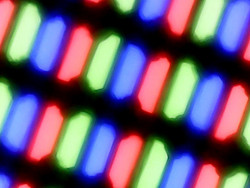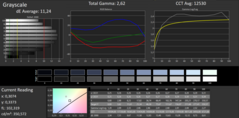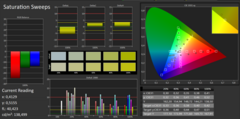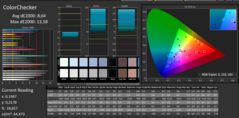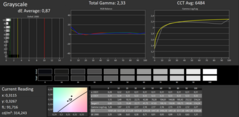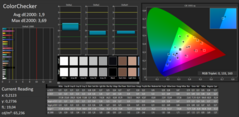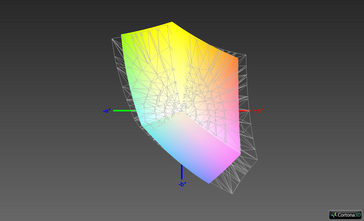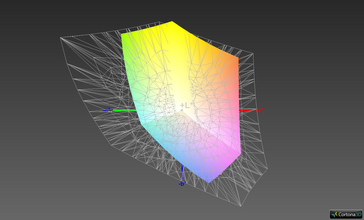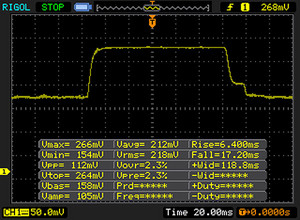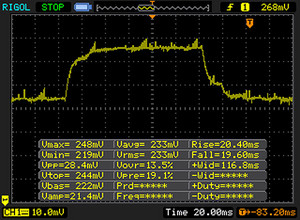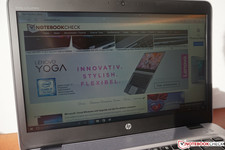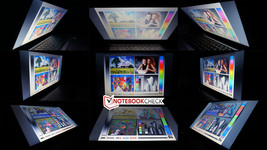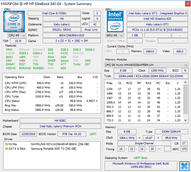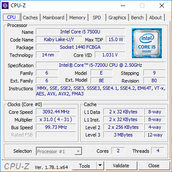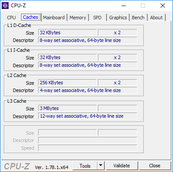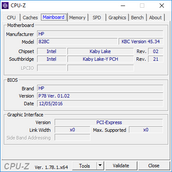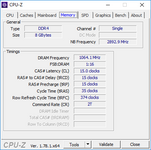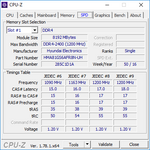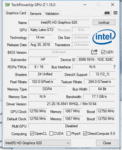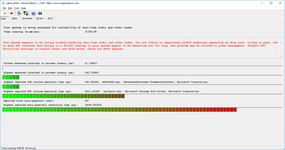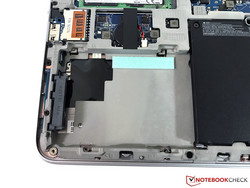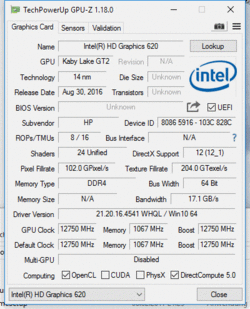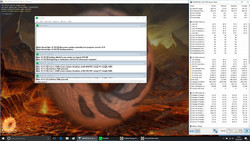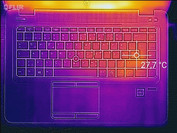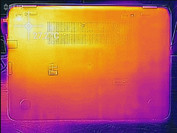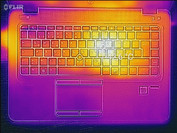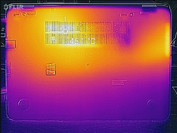HP EliteBook 840 G4 (7200U, Full HD) Laptop Review

For the original German review, see here.
The EliteBooks from the 800-series are premium business notebooks from HP. There are two more expensive EliteBooks with the additional Folio designation (1040, G1), but they have a bigger focus on mobility. The EliteBook 840 with its 14-inch display is already the fourth generation (G4), but there are only minor changes compared to the previous EliteBook 840 G3. More precisely: You only get a new processor from Intel's current Kaby Lake generation.
Our test model carries the designation Z2V49ET ABD and is a mainstream model from the 840 G4 lineup when you have a look at the available components. HP equips the test model with an Intel Core i5, 8 GB RAM, a 256 GB NVM-SSD as well as a Full HD display. The latter is unfortunately not an IPS screen but is based on TN technology, which was already the case for the previous model.
Is that enough to keep up with some of the completely reworked rivals? We already reviewed many new business laptops, including the Lenovo ThinkPad T470 & T470s and the Fujitsu LifeBook U747. Dell also offers the updated Latitude E7480, which is currently in review.
Case
The elegant case of the EliteBook 840 G4 did not change this year. HP once again uses a combination of magnesium alloy and painted aluminum, only the bottom is made of dark plastic. The palm rests are therefore cool to touch and fingerprints are no problem. We really like the design with the mixture of black and silver. The lid has a silver HP logo, but there are otherwise no design elements. HP uses a visual trick, because the chassis gets a bit slimmer towards the front, so the laptop itself appears thinner than it actually is.
The stability of the base unit is also good and only a lot of pressure can warp the surfaces, which also results in slight creaking sounds. The thin lid is not as stable and can easily be twisted. Pressure from behind will also create ripples on the screen. The hinges have black plastic covers and are smooth, but they have some play and the display will quickly bounce. The maximum opening angle is sufficient at ~145 degrees. We can hear some creaking from the hinges when we adjust the angle, but it is not as bad compared to some shown in user videos on the Internet. Obviously we cannot check the long-term effects during our short review period.
This is the second model year with the same chassis, but it still holds up very well in our size comparison. The footprint is very similar between all comparison devices. This is also the case for the height, except for the noticeably slimmer EliteBook Folio 1040 G3. At ~1.9 cm and a weight of around 1.5 kg, the 14-inch laptop is very portable and can easily be stored in a bag or backpack.
Connectivity
The ports did not change compared to the previous model. The EliteBook 840 G3 was already equipped with a modern USB-C jack, but it is still just a "regular" USB 3.1 port without support for Thunderbolt, DisplayPort, or power supply. At least you get all the other important components including two video outputs (DisplayPort 1.2, VGA) as well as a docking port. These connectors are very important for office environments.
The port layout is not perfect, because they are at the center of the two sides. If you do not use a docking station and still attach external devices, you will have to manage some cables. The performance of the USB ports (2x USB 3.0, 1x always-on) is decent at 310 MB/s on average (Samsung SSD T3), but it could be better.
SD-Card Reader
It is easy to miss the SD-card reader, because it is located very far to the bottom of the right side and there is also a small black plastic tray. The memory card does not stand out. We check the performance in combination with our reference card from Toshiba (Exceria Pro 64 GB UHS-II), which manages transfer rates of up to 260 MB/s according to the manufacturer. We only see average transfer rates and all the comparison devices are pretty much on par. A folder with pictures (~5 MB each) is transferred at almost 75 MB/s, while AS SSD determines up to ~84 MB/s.
| SD Card Reader | |
| average JPG Copy Test (av. of 3 runs) | |
| Lenovo ThinkPad T470s-20HGS00V00 | |
| Lenovo ThinkPad T470-20HD002HGE | |
| HP EliteBook 840 G4-Z2V49ET ABD | |
| Fujitsu LifeBook U747 | |
| HP EliteBook 840 G3 T9X59ET#ABD | |
| maximum AS SSD Seq Read Test (1GB) | |
| Lenovo ThinkPad T470s-20HGS00V00 | |
| Lenovo ThinkPad T470-20HD002HGE | |
| HP EliteBook 840 G4-Z2V49ET ABD | |
| HP EliteBook 840 G3 T9X59ET#ABD | |
| Fujitsu LifeBook U747 | |
Communication
HP implements a full-size Gigabit Ethernet port (folds out), despite the pretty slim base unit. Wireless network connections are handled by different Wi-Fi adapters from Intel. Our test model is equipped with the familiar 8265 adapter (2x2), which supports all common standards including the fast 802.11 ac as well as Bluetooth 4.2. Mobile Internet connections are possible as well thanks to the integrated Snapdragon X5 LTE module; the corresponding Micro-SIM can be inserted at the right side.
Our standardized WLAN test with the router Linksys EA8500 (one meter from the test system) does not determine any record values, but more than 500 Mbps is still a decent result. We did not experience any issues with the Wi-Fi connection during our review period, either.
The familiar HD webcam sits above the display, but the picture quality is bad. It does its job during video conferences, but we would like to see better sensors in the future. The dual-array microphone works well, as per usual, and an external headset is often unnecessary.
| Networking | |
| iperf3 transmit AX12 | |
| Lenovo ThinkPad T470-20HD002HGE | |
| HP EliteBook 840 G4-Z2V49ET ABD (jseb) | |
| Fujitsu LifeBook U747 | |
| Lenovo ThinkPad T470s-20HGS00V00 | |
| iperf3 receive AX12 | |
| Lenovo ThinkPad T470-20HD002HGE | |
| Fujitsu LifeBook U747 | |
| Lenovo ThinkPad T470s-20HGS00V00 | |
| HP EliteBook 840 G4-Z2V49ET ABD (jseb) | |
Security
The new EliteBook 840 G4 once again offers all relevant security features. This includes the fingerprint scanner (swipe-style), TPM, SmartCard reader, and a slot for a Kensington lock, for example. But HP also implements numerous software tools and features to increase the security of the laptop. This includes HP SureStat or HP Client Security, where many security-relevant settings (administration of passwords, fingerprints, hard drive encryption) are summarized. The EliteBook 840 G4 is also equipped with a vibration sensor, but it is only important for SKUs with mechanical hard drives.
Accessories
The box only includes the laptop, a compact 45-Watt power adapter and some service brochures. HP offers a number of optional accessories like several adapters and docking stations. The chassis did not change, so you can also use accessories from the previous generation.
Maintenance
It is no problem to loosen the screws after the removal of 10 rubber caps. You should not forget the screw in the SD-card slot, which is usually covered by a plastic tray. Once the bottom panel is removed, you get full access to all components. The empty RAM slot is particularly interesting. The free 2.5-inch slot features the necessary connector, but the corresponding mounting frame is missing.
Warranty
HP grants a limited three-year warranty for the EliteBook 840 G4, which can be extended or expanded, respectively, by optional CarePacks. An upgrade to a five-year on-site service, for example, retails for around 350 Euros (~$376).
Please see our Guarantees, Return Policies and Warranties FAQ for country-specific information.
Input Devices
Keyboard
The keyboard was already pretty good last year and HP did not change it. The black chiclet input (spillwater-proof) still provides a firm feedback with sufficient key travel. The individual keys are completely flat; rivals like Dell and Lenovo have an advantage with their slightly concave keys. You have to get used to the additional column on the right side as well as the small vertical directional keys.
All in all, we are still very satisfied with the keyboard and even longer texts are no problem. The illumination can be adjusted in three stages and improves inputs in low-light situations. The two additional buttons for the communication modules and the speakers at the upper right are very handy.
Touchpad
The touchpad is equipped with dedicated mouse buttons, but they are not perfectly integrated and clatter a bit. The clicking sounds do not leave the most sophisticated impression, either. The touchpad surface itself is not very large at 10 x 5.5 cm due to the dedicated buttons, but the handling is very good thanks to the smooth surface. Gestures are also executed well.
HP also includes a black PointStick. The cursor control is precise, but the stick is not as smooth as the counterparts from Lenovo or Dell, and it requires more force to initiate the cursor movement. A third scrolling button is unfortunately not available.
Display
HP offers many displays for the EliteBook 840 G4, and the two matte IPS models (1920x1080 or 2560x1440 pixels) are particularly interesting. Similar to the previous test model of the EliteBook 840, however, we are once again dealing with the FHD-TN panel. The TN technology is indicated by SVA (Standard Viewing Angle) in spec sheets from HP. There is a worse option with the HD TN panel, but the FHD screen is not particularly satisfying, either.
The best aspect is the high luminance, because we can determine an average of almost 320 nits. The black value is very high at 0.86 in return though, so dark surfaces always look grayish and the contrast suffers as well. The latter is only 402:1, despite the high luminance – insufficient for a modern business notebook priced at more than 1,500 Euros (~$1614). The result is a washed-out picture, which suffers from a heavy blue cast as well. At least there is no PWM.
| |||||||||||||||||||||||||
Brightness Distribution: 86 %
Center on Battery: 346 cd/m²
Contrast: 402:1 (Black: 0.86 cd/m²)
ΔE ColorChecker Calman: 8.64 | ∀{0.5-29.43 Ø4.77}
ΔE Greyscale Calman: 11.24 | ∀{0.09-98 Ø5}
80% sRGB (Argyll 1.6.3 3D)
52% AdobeRGB 1998 (Argyll 1.6.3 3D)
57.7% AdobeRGB 1998 (Argyll 3D)
80.7% sRGB (Argyll 3D)
55.8% Display P3 (Argyll 3D)
Gamma: 2.62
CCT: 12530 K
| HP EliteBook 840 G4-Z2V49ET ABD AUO123D, , 1920x1080, 14" | Lenovo ThinkPad T470-20HD002HGE N140HCA-EAB, , 1920x1080, 14" | Lenovo ThinkPad T470s-20HGS00V00 B140QAN01.5, , 2560x1440, 14" | Fujitsu LifeBook U747 LG LP140WF3, , 1920x1080, 14" | HP EliteBook Folio 1040 G3 AUO1136, , 2560x1440, 14" | HP EliteBook 840 G3 T9X59ET#ABD Chi Mei CMN14C0, , 1920x1080, 14" | |
|---|---|---|---|---|---|---|
| Display | -24% | 21% | 10% | 21% | -11% | |
| Display P3 Coverage (%) | 55.8 | 41.6 -25% | 69 24% | 66.1 18% | 67.9 22% | 48.93 -12% |
| sRGB Coverage (%) | 80.7 | 61.9 -23% | 95.1 18% | 84.8 5% | 96.8 20% | 73.7 -9% |
| AdobeRGB 1998 Coverage (%) | 57.7 | 43.06 -25% | 69.6 21% | 62 7% | 70 21% | 50.5 -12% |
| Response Times | -28% | -22% | 4% | -17% | -10% | |
| Response Time Grey 50% / Grey 80% * (ms) | 39 ? | 41.6 ? -7% | 46.4 ? -19% | 36 ? 8% | 46.4 ? -19% | 43 ? -10% |
| Response Time Black / White * (ms) | 23 ? | 34 ? -48% | 28.8 ? -25% | 23.2 ? -1% | 26.4 ? -15% | 25 ? -9% |
| PWM Frequency (Hz) | 204 ? | |||||
| Screen | 23% | 39% | 33% | 38% | 4% | |
| Brightness middle (cd/m²) | 346 | 306 -12% | 327 -5% | 291 -16% | 327 -5% | 366 6% |
| Brightness (cd/m²) | 317 | 287 -9% | 311 -2% | 296 -7% | 316 0% | 336 6% |
| Brightness Distribution (%) | 86 | 88 2% | 88 2% | 84 -2% | 87 1% | 87 1% |
| Black Level * (cd/m²) | 0.86 | 0.3 65% | 0.25 71% | 0.32 63% | 0.35 59% | 0.65 24% |
| Contrast (:1) | 402 | 1020 154% | 1308 225% | 909 126% | 934 132% | 563 40% |
| Colorchecker dE 2000 * | 8.64 | 6.2 28% | 6.1 29% | 4.3 50% | 4.39 49% | 10.26 -19% |
| Colorchecker dE 2000 max. * | 13.58 | 13.6 -0% | 12.2 10% | 7.5 45% | 7.27 46% | |
| Greyscale dE 2000 * | 11.24 | 5.8 48% | 8.8 22% | 4.3 62% | 4.69 58% | 11.51 -2% |
| Gamma | 2.62 84% | 2.04 108% | 2.18 101% | 2.31 95% | 2.15 102% | 2.4 92% |
| CCT | 12530 52% | 6277 104% | 6172 105% | 6529 100% | 7101 92% | 12725 51% |
| Color Space (Percent of AdobeRGB 1998) (%) | 52 | 39.62 -24% | 61.56 18% | 55.46 7% | 62.52 20% | 47 -10% |
| Color Space (Percent of sRGB) (%) | 80 | 61.44 -23% | 94.88 19% | 84.77 6% | 96.71 21% | 74 -7% |
| Total Average (Program / Settings) | -10% /
7% | 13% /
27% | 16% /
25% | 14% /
27% | -6% /
-1% |
* ... smaller is better
The blue cast is also supported in our further measurements with the X-Rite i1Pro2 spectrophotometer and the professional CalMAN software. Both the DelatE-2000 deviations for the grayscale (11.24) and the colors (8.64) compared to the sRGB reference clearly miss the target range (smaller 3). The color temperature is also too cool.
Our calibration improves the situation for the colors and the grayscale significantly. The strong blue cast is gone as well, so you should definitely calibrate the screen or use our icc-profile, which is linked in the box above.
The panel is still not suited for professional tasks in the graphics segment, because the color gamut (80% sRGB, 52% AdobeRGB) is limited.
Display Response Times
| ↔ Response Time Black to White | ||
|---|---|---|
| 23 ms ... rise ↗ and fall ↘ combined | ↗ 6 ms rise | |
| ↘ 17 ms fall | ||
| The screen shows good response rates in our tests, but may be too slow for competitive gamers. In comparison, all tested devices range from 0.1 (minimum) to 240 (maximum) ms. » 51 % of all devices are better. This means that the measured response time is worse than the average of all tested devices (20.2 ms). | ||
| ↔ Response Time 50% Grey to 80% Grey | ||
| 39 ms ... rise ↗ and fall ↘ combined | ↗ 20 ms rise | |
| ↘ 19 ms fall | ||
| The screen shows slow response rates in our tests and will be unsatisfactory for gamers. In comparison, all tested devices range from 0.165 (minimum) to 636 (maximum) ms. » 58 % of all devices are better. This means that the measured response time is worse than the average of all tested devices (31.6 ms). | ||
Screen Flickering / PWM (Pulse-Width Modulation)
| Screen flickering / PWM not detected | ||
In comparison: 53 % of all tested devices do not use PWM to dim the display. If PWM was detected, an average of 8084 (minimum: 5 - maximum: 343500) Hz was measured. | ||
The outdoor capabilities of the EliteBook are decent thanks to the matte screen surface. The luminance is not reduced on battery power, either, so you can also use the test model in bright environments.
One major issue of the TN panel is the extremely limited viewing-angle stability. It is not easy to find a good viewing position. Even slight deviations from this spot will reduce the contrast ratio even further or colors start to invert. We definitely recommend a model with an IPS display.
Performance
HP offers several components for the EliteBook 840 G4. You can choose between modern Kaby Lake ULV processors, starting with the Core i3-7100U all the way up to the Core i7-7600U. All SKUs use the integrated GPU, because dedicated graphics cards are not available. The two SODIMM memory slots support up to 32 GB DDR4-RAM. Storage options include conventional 2.5-inch HDDs as well as M.2 SSDs (SATA-III & PCIe), so the subjective system performance can differ significantly depending on the configuration.
Processor
Our test model of the EliteBook 840 G4 is equipped with the mainstream CPU option, the Core i5-7200U. The dual-core chip has a base frequency of 2.5 GHz, which can be raised all the way up to 3.1 GHz via Turbo Boost (also for two active cores). Hyper-Threading is supported as well, so the two cores can execute up to four threads simultaneously. The performance is more than sufficient for common office tasks.
There are no surprises in the benchmarks. The 15-Watt TDP is sufficient for the Kaby-Lake chip, and the performance can be maintained in the multithread test.
The performance on battery power is reduced because the Turbo Boost is deactivated by default. This is supposed to increase the battery runtime, but we will have a closer look at the results later in the corresponding section. The Cinebench Multi test determines 252 points without Turbo Boost (-24%). It is still possible to get the full performance without the PSU attached; you just have to activate the BIOS option "Enable Turbo Boost on DC". More benchmarks with the Core i5-7200U are available in our Tech section.
System Performance
The system performance of our test model definitely benefits from the fast PCIe-SSD. Inputs are executed immediately and applications are launched without delays. The overall hardware configuration is very balanced and there are no bottlenecks. All comparison devices are very close to each other and the EliteBook 840 G4 manages average scores in the synthetic PCMark 8 benchmarks. It would be possible to increase the scores a bit with a faster processor and more RAM, but you will hardly notice the difference in practice.
| PCMark 8 Home Score Accelerated v2 | 3486 points | |
| PCMark 8 Creative Score Accelerated v2 | 4352 points | |
| PCMark 8 Work Score Accelerated v2 | 4572 points | |
Help | ||
Storage Devices
The EliteBook 840 G4 is either equipped with conventional 2.5-inch HDDs or M.2-2280 SSDs. Our test model is shipped with the Samsung PM961 with a storage capacity of 256 GB. The NVMe drive is attached via PCIe and is currently used for many high-end business notebooks. The benchmark results are very good and the sequential transfer rates in particular are superior to SATA-III drives. More benchmarks for many HDDs & SSDs are listed in our comprehensive comparison.
| HP EliteBook 840 G4-Z2V49ET ABD Samsung PM961 MZVLW256HEHP | Lenovo ThinkPad T470-20HD002HGE Samsung PM961 NVMe MZVLW512HMJP | Lenovo ThinkPad T470s-20HGS00V00 Samsung SSD PM961 1TB M.2 PCIe 3.0 x4 NVMe (MZVLW1T0) | Fujitsu LifeBook U747 Samsung MZYTY256HDHP | HP EliteBook Folio 1040 G3 Samsung SM951 MZVPV256HDGL m.2 PCI-e | HP EliteBook 840 G3 T9X59ET#ABD Samsung SSD PM851 256 GB MZNTE256HMHP | |
|---|---|---|---|---|---|---|
| CrystalDiskMark 3.0 | -10% | 12% | -50% | 9% | -56% | |
| Read Seq (MB/s) | 1819 | 1155 -37% | 1760 -3% | 504 -72% | 1649 -9% | 497.8 -73% |
| Write Seq (MB/s) | 1263 | 1076 -15% | 1666 32% | 497.8 -61% | 1265 0% | 241.4 -81% |
| Read 512 (MB/s) | 922 | 811 -12% | 832 -10% | 396.7 -57% | 1252 36% | 396 -57% |
| Write 512 (MB/s) | 804 | 862 7% | 1064 32% | 283.4 -65% | 1244 55% | 241.8 -70% |
| Read 4k (MB/s) | 61.4 | 55.5 -10% | 53.2 -13% | 35.73 -42% | 53.3 -13% | 27.02 -56% |
| Write 4k (MB/s) | 157.1 | 134.6 -14% | 167.4 7% | 87.8 -44% | 159.9 2% | 82.6 -47% |
| Read 4k QD32 (MB/s) | 513 | 496.2 -3% | 630 23% | 399.1 -22% | 559 9% | 388.5 -24% |
| Write 4k QD32 (MB/s) | 410.2 | 425.4 4% | 533 30% | 249.7 -39% | 376.7 -8% | 242.8 -41% |
GPU Performance
We already mentioned that the EliteBook 840 G4 is not available with dedicated graphics cards. All the graphics calculations are handled by the integrated Intel HD Graphics 620 of the processor. The maximum core clock can vary depending on the CPU model; our GPU can reach up to 1000 MHz.
The graphics performance is sufficient for an office device, but you cannot utilize the full performance of the GPU due to the single-channel RAM. The additional memory bandwidth from a second RAM module can increase the graphics performance by roughly 20-30% (also see ThinkPad T470s).
The performance of the graphics card is not reduced on battery performance, more benchmarks are listed here.
| 3DMark 11 Performance | 1525 points | |
| 3DMark Ice Storm Standard Score | 50497 points | |
| 3DMark Cloud Gate Standard Score | 5621 points | |
| 3DMark Fire Strike Score | 697 points | |
Help | ||
Gaming Performance
It is no surprise that the performance of the integrated GPU is not sufficient for modern games. You are also limited to low details and resolutions for older titles like BioShock Infinite, for example. A second RAM module could increase the fps number by a couple of percent, but this will obviously not transform the EliteBook 840 G4 into a gaming laptop. Our gaming list shows what games can be played with the integrated HD 620.
| low | med. | high | ultra | |
|---|---|---|---|---|
| BioShock Infinite (2013) | 40.5 | 24.3 | 19.8 | 6.4 |
| Battlefield 4 (2013) | 30.7 | 24.5 | 15.7 | |
| The Witcher 3 (2015) | 12.9 |
Emissions
System Noise
The HP EliteBook 840 G4 is a very quiet laptop. The fan is deactivated while idling or with light workloads and we cannot hear any annoying sounds, either. This is obviously not the case for SKUs with mechanical hard drives.
The fan is very restrained under load at up to 33.7 dB(A) and you can only hear a quiet murmur. This is also a very good result within the comparison group.
Noise level
| Idle |
| 31 / 31 / 31 dB(A) |
| Load |
| 33.5 / 33.7 dB(A) |
 | ||
30 dB silent 40 dB(A) audible 50 dB(A) loud |
||
min: | ||
| HP EliteBook 840 G4-Z2V49ET ABD i5-7200U, HD Graphics 620 | Lenovo ThinkPad T470-20HD002HGE i5-7200U, HD Graphics 620 | Lenovo ThinkPad T470s-20HGS00V00 i7-7600U, HD Graphics 620 | Fujitsu LifeBook U747 i5-7200U, HD Graphics 620 | HP EliteBook Folio 1040 G3 6300U, HD Graphics 520 | HP EliteBook 840 G3 T9X59ET#ABD 6500U, HD Graphics 520 | |
|---|---|---|---|---|---|---|
| Noise | 6% | -2% | 8% | 3% | -6% | |
| off / environment * (dB) | 31 | 28 10% | 28.9 7% | 28.2 9% | 29.1 6% | 31.2 -1% |
| Idle Minimum * (dB) | 31 | 28 10% | 28.9 7% | 28.2 9% | 29.1 6% | 31.2 -1% |
| Idle Average * (dB) | 31 | 28 10% | 28.9 7% | 28.2 9% | 29.1 6% | 32.1 -4% |
| Idle Maximum * (dB) | 31 | 29.4 5% | 30.1 3% | 28.2 9% | 29.1 6% | 33.1 -7% |
| Load Average * (dB) | 33.5 | 31.4 6% | 39.2 -17% | 31.2 7% | 32.6 3% | 36.2 -8% |
| Load Maximum * (dB) | 33.7 | 34.6 -3% | 39.2 -16% | 33 2% | 37.8 -12% | 37.8 -12% |
* ... smaller is better
Temperature
The temperature development is moderate, despite the restrained fan. The chassis does not really warm up at all with light workloads and it is no problem to use the system on your lap, even when you really stress it.
We can see the typical ULV behavior in the stress test with the tools Prime95 and FurMark. The processor (3.1 GHz) and graphics card (1000 MHz) start with their respective maximum clocks before the TDP limit at 15 Watts sets in after a short time (28 seconds). The CPU clock will drop to 2.6-2.8 GHz and the GPU can maintain its maximum clock. The temperature of 65 °C is no problem, either. A 3DMark 11 run immediately after the stress test did not determine a lower score, which is no surprise.
(+) The maximum temperature on the upper side is 37 °C / 99 F, compared to the average of 34.3 °C / 94 F, ranging from 21.2 to 62.5 °C for the class Office.
(+) The bottom heats up to a maximum of 39.4 °C / 103 F, compared to the average of 36.8 °C / 98 F
(+) In idle usage, the average temperature for the upper side is 25 °C / 77 F, compared to the device average of 29.5 °C / 85 F.
(+) The palmrests and touchpad are cooler than skin temperature with a maximum of 27.4 °C / 81.3 F and are therefore cool to the touch.
(±) The average temperature of the palmrest area of similar devices was 27.6 °C / 81.7 F (+0.2 °C / 0.4 F).
Speakers
The two stereo speakers produce decent results in our audio analysis with balanced mids and high tones. Bass is limited though, so the sound is rather tinny. The sound characteristics are favorable for voices in conferences or VoIP calls, for example.
However, the two modules are comparatively quiet at up to 66 dB(A). This is sufficient for your work space, but you should use external solutions in larger meetings.
HP EliteBook 840 G4-Z2V49ET ABD audio analysis
(-) | not very loud speakers (66 dB)
Bass 100 - 315 Hz
(±) | reduced bass - on average 14.6% lower than median
(±) | linearity of bass is average (7.8% delta to prev. frequency)
Mids 400 - 2000 Hz
(+) | balanced mids - only 0.7% away from median
(+) | mids are linear (3.4% delta to prev. frequency)
Highs 2 - 16 kHz
(+) | balanced highs - only 3.9% away from median
(+) | highs are linear (5.4% delta to prev. frequency)
Overall 100 - 16.000 Hz
(±) | linearity of overall sound is average (16.2% difference to median)
Compared to same class
» 18% of all tested devices in this class were better, 6% similar, 76% worse
» The best had a delta of 7%, average was 21%, worst was 53%
Compared to all devices tested
» 25% of all tested devices were better, 5% similar, 69% worse
» The best had a delta of 4%, average was 24%, worst was 134%
Lenovo ThinkPad T470-20HD002HGE audio analysis
(±) | speaker loudness is average but good (80.4 dB)
Bass 100 - 315 Hz
(-) | nearly no bass - on average 16.6% lower than median
(±) | linearity of bass is average (8.8% delta to prev. frequency)
Mids 400 - 2000 Hz
(+) | balanced mids - only 4.3% away from median
(+) | mids are linear (6.7% delta to prev. frequency)
Highs 2 - 16 kHz
(±) | higher highs - on average 5.4% higher than median
(±) | linearity of highs is average (13.3% delta to prev. frequency)
Overall 100 - 16.000 Hz
(±) | linearity of overall sound is average (18.7% difference to median)
Compared to same class
» 33% of all tested devices in this class were better, 6% similar, 60% worse
» The best had a delta of 7%, average was 21%, worst was 53%
Compared to all devices tested
» 42% of all tested devices were better, 8% similar, 50% worse
» The best had a delta of 4%, average was 24%, worst was 134%
Frequency comparison (checkboxes select/deselectable!)
Energy Management
Power Consumption
There are no surprises in our consumption measurements, and the test model is even among the most efficient laptops within the comparison group. The load measurements easily show what devices are bound by the usual TDP limit, because they will hover around 30-32 Watts. Our EliteBook 840 G4 is such a device. The compact 45-Watt power adapter is sufficient for the maximum consumption.
| Off / Standby | |
| Idle | |
| Load |
|
Key:
min: | |
| HP EliteBook 840 G4-Z2V49ET ABD i5-7200U, HD Graphics 620, 1920x1080, 14" | Lenovo ThinkPad T470-20HD002HGE i5-7200U, HD Graphics 620, 1920x1080, 14" | Lenovo ThinkPad T470s-20HGS00V00 i7-7600U, HD Graphics 620, 2560x1440, 14" | Fujitsu LifeBook U747 i5-7200U, HD Graphics 620, 1920x1080, 14" | HP EliteBook Folio 1040 G3 6300U, HD Graphics 520, 2560x1440, 14" | HP EliteBook 840 G3 T9X59ET#ABD 6500U, HD Graphics 520, 1920x1080, 14" | |
|---|---|---|---|---|---|---|
| Power Consumption | -2% | -44% | -19% | -56% | -6% | |
| Idle Minimum * (Watt) | 2.9 | 3.21 -11% | 4.64 -60% | 4.11 -42% | 6.3 -117% | 3.8 -31% |
| Idle Average * (Watt) | 5.6 | 6.15 -10% | 8.93 -59% | 7.87 -41% | 9.4 -68% | 6.3 -13% |
| Idle Maximum * (Watt) | 8.15 | 6.82 16% | 9.12 -12% | 8.74 -7% | 10.1 -24% | 6.8 17% |
| Load Average * (Watt) | 30.6 | 28.5 7% | 42.2 -38% | 30.2 1% | 33.3 -9% | 34.4 -12% |
| Load Maximum * (Watt) | 31 | 34.5 -11% | 47.3 -53% | 32.4 -5% | 49.5 -60% | 28.3 9% |
* ... smaller is better
Battery Runtime
The battery capacity was increased to 51 Wh. Our test model just slightly misses the 10-hour mark in our practical runtime tests at an adjusted luminance (how we test). It should therefore not be a problem to manage a full business day.
You can expect little more than 3 hours when you really stress the system. We determined this value with the default BIOS settings, where the Turbo Boost of the CPU is deactivated in favor of longer battery runtimes. We were obviously curious to see the result with the full performance (Enable Turbo Boost on DC). A second test resulted in 114 minutes, so the runtime is considerably shorter.
A full recharge of the battery takes about 2:20 hours when the device is turned on.
| HP EliteBook 840 G4-Z2V49ET ABD i5-7200U, HD Graphics 620, 51 Wh | Lenovo ThinkPad T470-20HD002HGE i5-7200U, HD Graphics 620, 48 Wh | Lenovo ThinkPad T470s-20HGS00V00 i7-7600U, HD Graphics 620, 51 Wh | Fujitsu LifeBook U747 i5-7200U, HD Graphics 620, 50 Wh | HP EliteBook Folio 1040 G3 6300U, HD Graphics 520, 45.6 Wh | HP EliteBook 840 G3 T9X59ET#ABD 6500U, HD Graphics 520, 46 Wh | |
|---|---|---|---|---|---|---|
| Battery runtime | -20% | -32% | -27% | -43% | -18% | |
| Reader / Idle (h) | 19.3 | 13.1 -32% | 13 -33% | 8.8 -54% | 17 -12% | |
| H.264 (h) | 9.9 | 10.4 5% | 7.6 -23% | 8.2 -17% | 5.7 -42% | |
| WiFi v1.3 (h) | 9.5 | 7.3 -23% | 7 -26% | 7.2 -24% | 5.2 -45% | 7.6 -20% |
| Load (h) | 3.1 | 1.8 -42% | 1.6 -48% | 2 -35% | 2.2 -29% | 2.4 -23% |
Pros
Cons
Verdict
The new HP EliteBook 840 G4 is basically just a Kaby Lake update of the previous G3 model. Both the size and the quality of the case still hold up well against the competition, only some issues like the creaking hinges or the clattery dedicated touchpad buttons affect the good impression a bit. The access to the components is another positive aspect: Upgrading the RAM is no problem, for example. We still really like the input devices – the keyboard in particular.
The 14-inch business laptop does not disappoint in terms of performance or emissions, either. The laptop is quiet, does not get overly warm, and the Intel Core i5-7200U can utilize its performance potential really well. HP also increased the battery capacity, which results in practical runtimes of almost 10 hours.
Good chassis, sufficient performance, low emissions – the fourth generation of the HP EliteBook 840 could be a very good business laptop. This is prevented by the bad TN panel, which has no place in a laptop for more than 1,500 Euros (~$1614).
That HP only slightly updated the EliteBook this year is made evident with the ports. You get all the important connectors for the office, but there is no future-proof Thunderbolt 3.
The biggest problem, however, is the Full HD TN display. Luminance and resolution are okay, but the panel disappoints in pretty much all the other measurements. The limited viewing-angle stability is a real issue in practice. Such a panel should not be used in a business laptop for more than 1,500 Euros (~$1614). If you are interested in the EliteBook 840, you should definitely get an IPS model. We cannot recommend our test sample with the TN screen.
HP EliteBook 840 G4-Z2V49ET ABD
- 05/26/2017 v6 (old)
Andreas Osthoff




